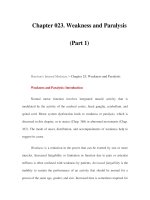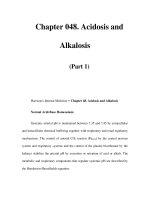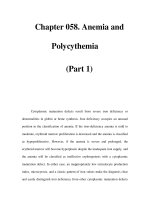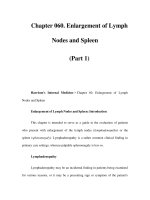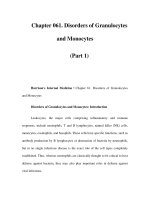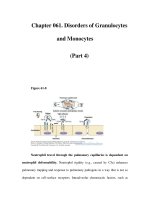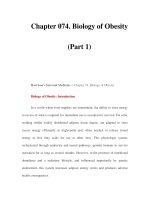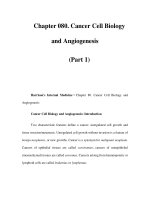Chapter 080. Cancer Cell Biology and Angiogenesis (Part 1) pps
Bạn đang xem bản rút gọn của tài liệu. Xem và tải ngay bản đầy đủ của tài liệu tại đây (48.23 KB, 5 trang )
Chapter 080. Cancer Cell Biology
and Angiogenesis
(Part 1)
Harrison's Internal Medicine > Chapter 80. Cancer Cell Biology and
Angiogenesis
Cancer Cell Biology and Angiogenesis: Introduction
Two characteristic features define a cancer: unregulated cell growth and
tissue invasion/metastasis. Unregulated cell growth without invasion is a feature of
benign neoplasms, or new growths. Cancer is a synonym for malignant neoplasm.
Cancers of epithelial tissues are called carcinomas; cancers of nonepithelial
(mesenchymal) tissues are called sarcomas. Cancers arising from hematopoietic or
lymphoid cells are called leukemias or lymphomas.
Cancer is a genetic disease. The malignant phenotype often requires
mutations in several different genes that regulate cell proliferation, survival, DNA
repair, motility, invasion, and angiogenesis (Table 80-1). Cancer-causing
mutations often activate signal transduction pathways leading to aberrant cell
proliferation and perturbations of tissue-specific differentiation programs. The
normal cell has protective mechanisms that lead to the repair of DNA damage that
occurs during DNA synthesis and mitosis and in response to environmental
mutagens; these repair pathways are often abnormal in cancer cells. When a
normal cell has sustained too much damage to repair, the cell activates a suicide
pathway to prevent damage to the organ. These cell death pathways are also
commonly altered in cancer cells, leading to the survival of damaged cells that
would normally die. Cancer cells often exist under conditions of low oxygen
tension (hypoxia) and nutrient deprivation, and selective pressure leads to the
outgrowth of neoplastic variants that can survive under these conditions through
the upregulation of a series of hypoxia-inducible genes (see below). The
acquisition of novel phenotypic characteristics includes those that facilitate
invasion and metastasis, such as the ability to break through basement membranes,
migrate through the extracellular matrix and into the vascular compartment, and
generate new blood vessels to support colonization in remote sites. The
accumulation of genetic lesions may lead through an identifiable progression of
altered phenotypes as is noted in colon cancer: hyperplasia →adenoma
→dysplasia →carcinoma in situ →invasive carcinoma. Premalignant changes
have also been identified in prostate, breast, and pancreatic cancers.
Table 80-1 Phenotypic Characteristics of Malignant Cells
Deregulated cell proliferation:
Loss of negative regulators (suppressor
oncogenes, i.e., Rb, p53), and increased positive regulators (oncogenes, i.e., Ras
,
Myc
). Leads to aberrant cell cycle control and includes loss of normal checkpoint
responses.
Failure to differentiate:
Arrest at a stage prior to terminal differentiation.
May retain stem cell p
roperties. (Frequently observed in leukemias due to
transcriptional repression of developmental programs by the gene products of
chromosomal translocations.)
Loss of normal apoptosis pathways:
Inactivation of p53, increases in
Bcl-2 family members. This
defect enhances the survival of cells with oncogenic
mutations and genetic instability and allows clonal expansion and diversification
within the tumor without activation of physiologic cell death pathways.
Genetic instability: Defects in DNA repair path
ways leading to either
single or oligo-
nucleotide mutations, (as in microsatellite instability, MIN) or
more commonly chromosomal instability (CIN) leading to aneuploidy. Caused by
loss of function of p53, BRCA1/2, mismatch repair genes, and others.
Loss of replicative senescence: Normal cells stop dividing after 25–
50
population doublings. Arrest is mediated by the Rb, p16
INK4a
, and p53 pathways.
Further replication leads to telomere loss, with crisis. Surviving cells often harbor
gross chromosomal abnormalities.
Increased angiogenesis:
Due to increased gene expression of
proangiogenic factors (VEGF, FGF, IL-
8) by tumor or stromal cells, or loss of
negative regulators (endostatin, tumstatin, thrombospondin).
Invasion: Loss of cell-cell contacts (gap
junctions, cadherens) and
increased production of matrix metalloproteinases (MMPs). Often takes the form
of epithelial-to-
mesenchymal transition (EMT) with anchored epithelial cells
becoming more like motile fibroblasts.
Metastasis: Spread of tumor cells
to lymph nodes or distant tissue sites.
Limited by the ability of tumor cells to survive in a foreign environment.
Evasion of the immune system:
Downregulation of MHC class I and II
molecules; induction of T cell tolerance; inhibition of normal dendriti
c cell and/or
T cell function; antigenic loss variants and clonal heterogeneity.
Note:
VEGF, vascular endothelial growth factor; FGF, fibroblast growth
factor; IL, interleukin.
